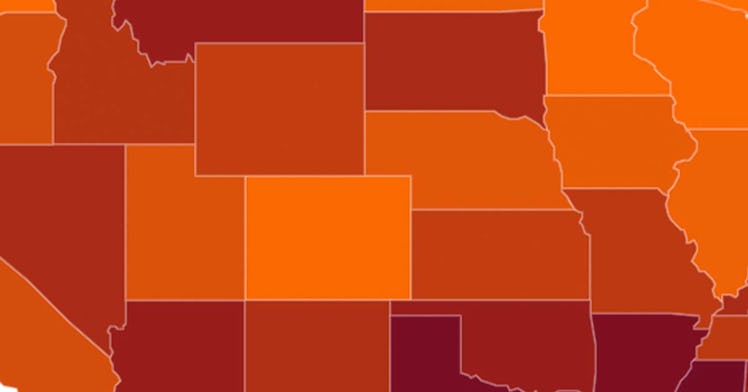This Map Shows The Best And Worst States For Climate Change
Florida and Texas need to get its act together.

Climate change is here, and there’s no denying that much of our lives will have to change in order to fight the threat to our planet and our lives. One inevitability is that states and governments will have to invest in green energy and climate resiliency in order to deal with bigger, wetter, and hotter seasons and storms.
In that vein, Policygenius compiled some data that narrows down what states in the contiguous United States are preparing, or are better prepared, to tackle climate change than others — based on what they’re doing now — and the results are not so great.
Policygenius set out to calculate which states were better prepared to tackle the climate change issue than others by ranking each contiguous state from 1-to-48 based on five different categories: drought, extreme heat, flooding, wildfires, and climate change preparedness.
“We then took the sum of the scores for each factor, calculated the average, and divided each state’s average by 48 to get a percentage,” they explain. In this case, the higher the number, the better, and the percentage became each state’s index score.
According to the data compiled, some states are preparing for climate change and taking their risk factors seriously. Others are not doing enough to better prepare the state, and those that live there, for climate change.
Looking at the factors Policygenius set out, the state has a “better outlook in a low or high-emissions future,” is Michigan. “The Great Lakes State takes the top spot in our index thanks in large part to its fairly low susceptibility to most of the major climate threats,” the site determined. They added: “Michigan also received a respectable B grade in preparedness from Climate Central, which noted actions the state has taken to adapt and improve resilience to climate change-related drought.”
The other states that round out the top five in preparedness for climate change include Vermont (primarily due to its low risk of extreme heat), Pennsylvania (due to its low drought vulnerability and high preparedness), Colorado (which has considerable wildfire and water-stress risk but low susceptibility to extreme heat), and Minnesota (thanks to its low flood risk.)
Unfortunately, five other states are on the opposite end of the climate change spectrum. The fifth-worst state is Arkansas (due to rising temperatures), the fourth-worst goes to Texas (due to its water risk and lack of preparedness), third place for worst goes to Louisiana (due to extreme heat risk and highest flood risk, being an extemely coastal state).
The state sitting as the second-worst for climate change is Mississippi (due to its vulnerability to extreme heat). The state that takes home the worst for climate change is Florida, which nabbed the title due to extreme heat and flooding risks paired with being the state with the “highest number of residents living in inland and coastal floodplain.”

So what should people do with this information? Hopefully, those who live in the states with a much higher risk of seeing negative effects of climate change speak out.
According to a 2018 report released by the Intergovernmental Panel on Climate Change, we must make drastic shifts to cut carbon emissions over the next decade. If we don’t, the climate in many states will become uninhabitable, and some states will suffer more badly than others.